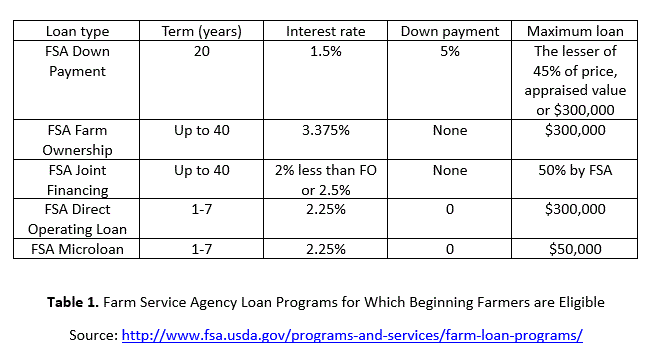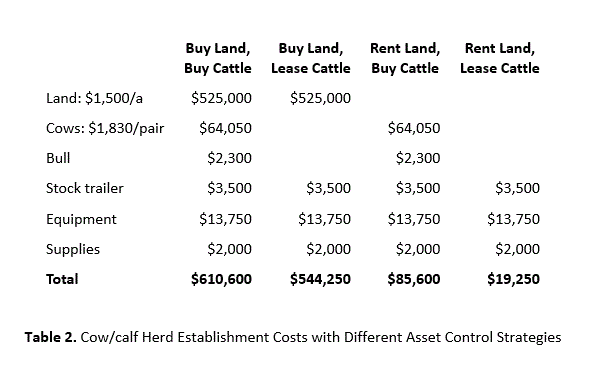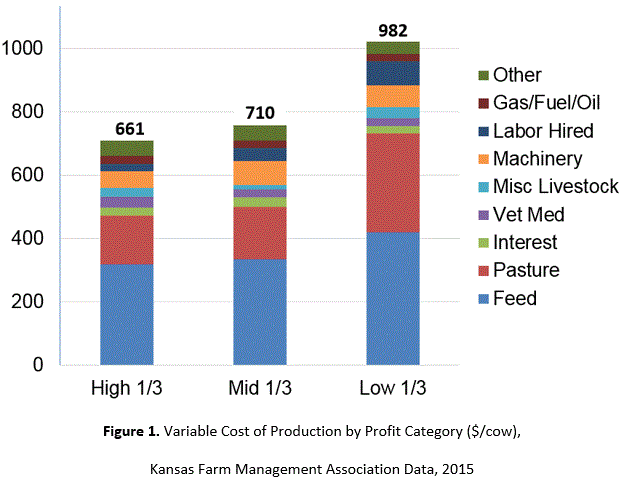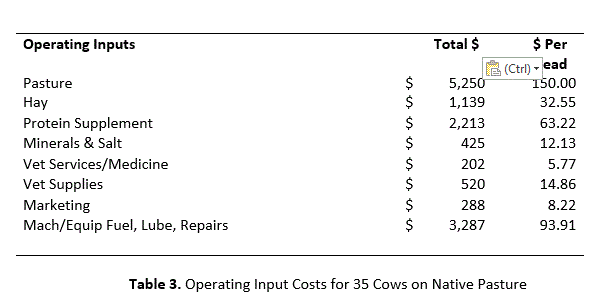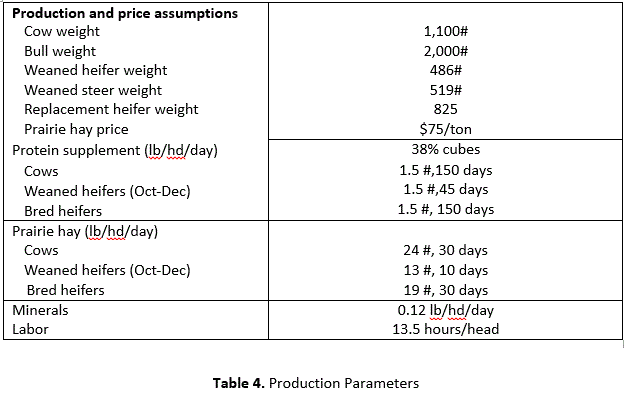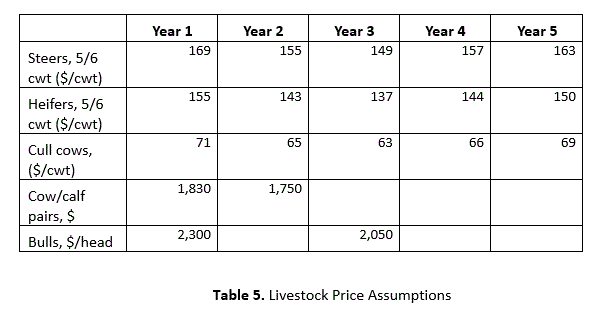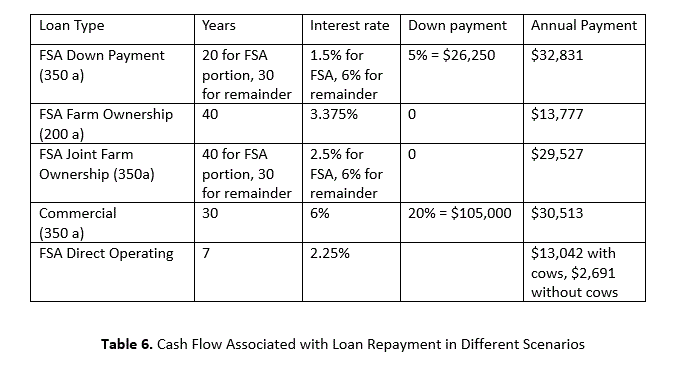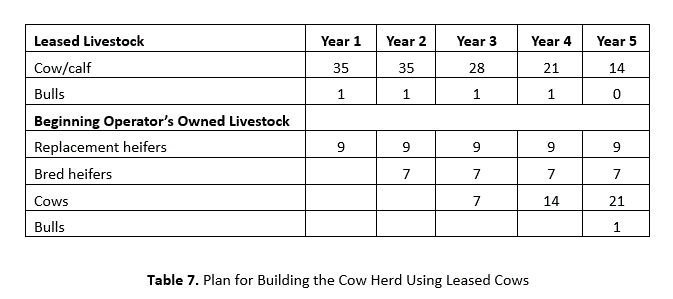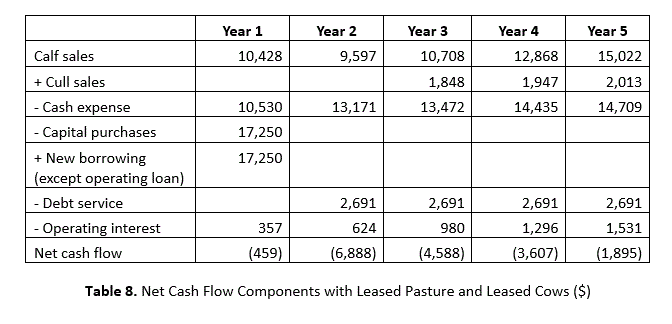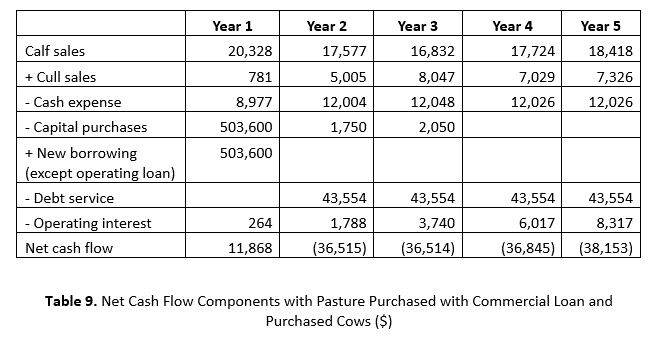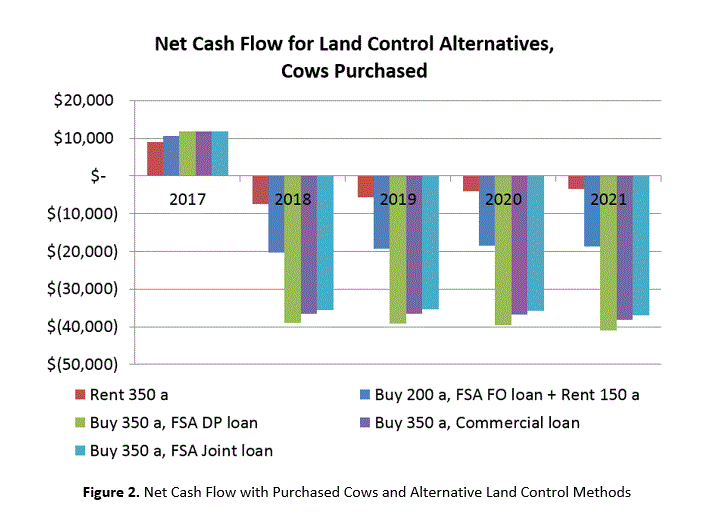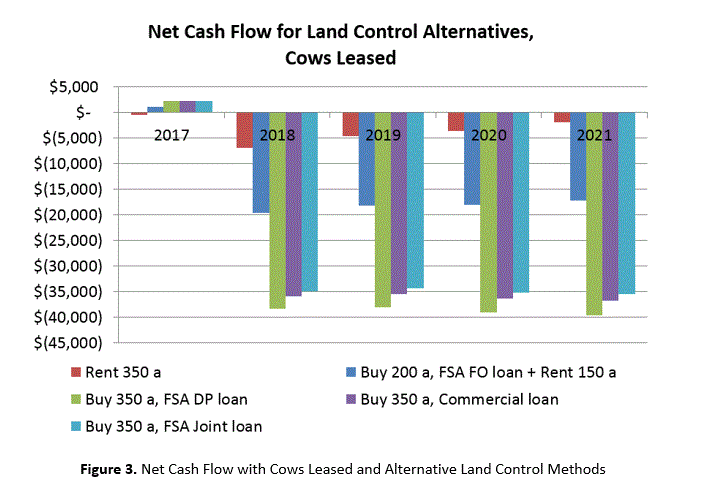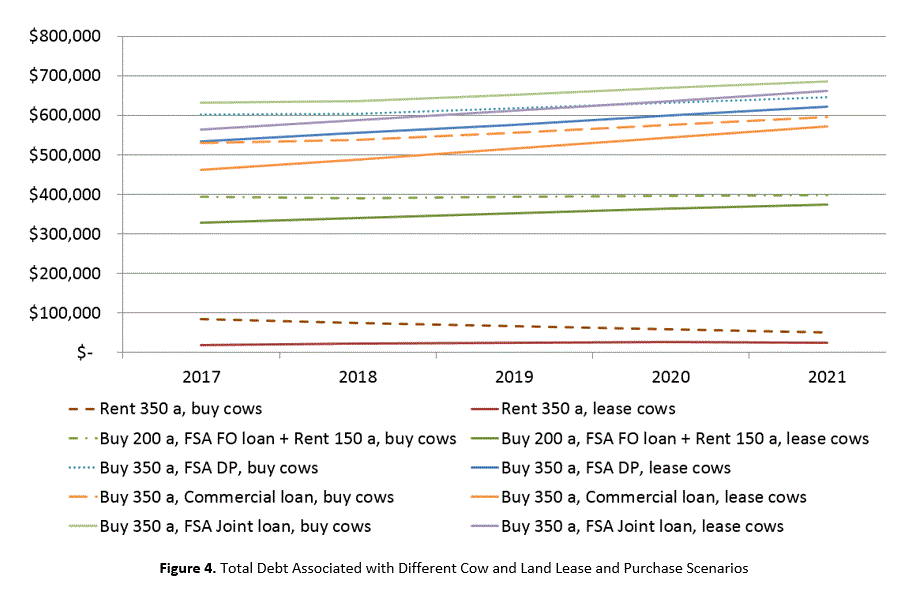Journal of the NACAA
ISSN 2158-9429
Volume 9, Issue 2 - December, 2016
Financing Alternatives for Beginning Cow/Calf Operations
- Doye, D. , Regents Professor and Rainbolt Chair of Agricultural Finance, Oklahoma State University
Sahs, R. , Assistant Extension Specialist, Oklahoma State University Department of Agricultural Economics
ABSTRACT
Cow/calf operations are a popular enterprise in American agriculture. However, high costs for land and other durable assets as well as operating expenses together with lower cattle prices may create barriers to entry. This paper analyzes leasing and purchasing options for both land and cows using commercial sources of credit and USDA Farm Service Agency loan programs. Cash flow, credit lines and debt levels over time are projected for comparison. Leasing cows and land offers a viable means of beginning cow/calf production. However, significant outside income is needed to purchase land.
Introduction
Beef production is one of the most common enterprises on farms nationwide. In 2012, the Census of Agriculture counted 2,109,303 farms, and approximately 35 percent had cattle and calves (USDA NASS 2014, Table 44). The average age of farmers continues to slowly increase, suggesting opportunities for taking over operations as older producers retire. Interest in beginning cow/calf production grew with high cattle prices and the historically small cow inventory; however, a new lower price and profit scenario means potential producers need to carefully investigate potential returns before investing.
Assets for agricultural production are primarily controlled through leases or purchases. Leasing assets is helpful for beginning producers as it requires less capital, focuses working capital on operating costs rather than debt payments, and lessens exposure to risk. Leasing land is common in the U.S.: approximately one-third of farm principal operators lease land for their operation (USDA NASS 2014, Table 70). Livestock leasing is less common, perhaps even uncommon in some parts of the country.
Livestock leasing arrangements can be either cash or share leases (Dhuyvetter and Doye, 2013). For the cow owner, leasing can generate income while shifting labor requirements to the cow operator, who has full control and responsibility for management unless otherwise specified. A cash lease provides fixed income for the cow owner, often on a per cow basis, with the cow operator incurring production risk. With a share lease, the cow operator may benefit from favorable production while the cow owner and operator share production risk and production decisions, which may complicate management.
Farm asset purchases are primarily financed by commercial banks, Farm Credit Services, and private individuals, with these three groups holding 95 percent of the agricultural debt outstanding at year-end as reported by farm operators for their businesses (Harris et al., 2009). USDA’s Farm Service Agency (FSA; 2016) also makes some supervised direct loans to producers, primarily beginning or socially disadvantaged farmers, who have been turned down for loans from commercial sources (www.usda.fsa.gov). FSA loan programs for which beginning farmers are eligible include a down payment program (DP), farm ownership loans (FO), joint financing arrangements, land contract guarantees, microloans and direct operating loans (OL). While commercial lenders may be interested in lending to younger and beginning operators, they typically do not offer concessionary programs because of the higher risk associated with these loans; in contrast, FSA offers preferential terms for beginning producers. FSA loan program parameters are summarized in Table 1.
For beginning producers, both profitability and cash flow are critical. While many beginning producers have purchasing land as a goal, it may contribute to cash flow as well as profitability problems in the short run, even if land ownership is a good long term investment strategy. The objective of this paper is to evaluate financing alternatives for beginning a cow/calf operation using purchased and leased cows and land. The results will help inform prospective new producers and educators of the financial challenges in beginning a beef operation.
Methods
To evaluate the feasibility of establishing a small cow/calf operation, herd establishment costs, expected maintenance costs and production data, plus terms associated with alternative asset control options (lease versus purchase) are identified. The resulting cash flow is estimated for alternative scenarios using whole farm financial planning software, Integrated Farm Financial Statements (IFFS) (Doye et al., 2000). A total of 10 scenarios are evaluated with purchased or leased cows: rent 350 acres; purchase 200 acres with a FSA FO loan and rent 150 acres; purchase 350 acres using an FSA DP loan; purchase 350 acres using a FSA joint loan; and purchase 350 acres with money borrowed from a commercial lender. In all cases, the beginning producer is assumed to be eligible for the FSA OL for financing operating inputs. In IFFS, cash shortfalls accumulate in the line of credit balance.
Cow/Calf Herd Establishment Costs
We estimate the costs associated with a small herd of 35 cows and one bull similar in size to the average for Oklahoma and U.S. herds. The average beef cow herd in Oklahoma in 2012 was 38 head; average herd size from 1987-2012 varied from 38 to 44 head (USDA NASS various issues). The average U.S. beef cow herd during that same time period varied from 40 to 43, also with the low in 2012 (USDA NASS, various issues). For this analysis, maintaining a cow requires approximately 10 acres of native pasture, or a total land base of 350 acres for a 35 cow herd. We assume a native range forage base as it is often the most cost effective means of maintaining cattle. Native pastureland is typically less expensive to rent as well as less expensive to buy than introduced pasture since the land on which introduced pasture is grown is likely suitable for crops with higher per acre returns than livestock enterprises (exceptions may occur in areas with high wildlife and recreational income potential). In Oklahoma, native pasture rents average approximately $15 per acre (Doye and Sahs, 2015) and pasture land values average approximately $1,500 per acre (agecon.okstate.edu/oklandvalues).
In the purchased cow scenarios, cow/calf pairs are initially purchased for $1,830 along with a bull for $2,300. Table 2 summarizes the assets presumed to be used in the operation. The investment needed to establish even a small herd of 35 cows varies enormously depending on whether assets are purchased or leased. Clearly, purchasing land dramatically increases the capital investment requirement. If debt payments can be made and land appreciates in value over time, land purchases can result in growth in equity and thus be a good long term investment. However, renting land typically presents less of a cash flow burden than buying land (here, rent is $150 per cow). It may also be more profitable in the short run or intermediate run.
Cow/Calf Operating Costs
Although beef production is a common enterprise in the U.S., profitability is certainly not guaranteed. Kansas Farm Management Association (KFMA) data (2015) indicates average variable cost per cow of $833 per cow with a difference in total expense between the high- and low-profit category producers of approximately $346 per cow in 2015 (Figure 1). The southwest Standardized Performance Analysis (SPA) data for 2009-13 shows an average raised/purchased feed cost of $200 per cow and grazing cost of $107 per cow, with total financial cost (includes operating and fixed costs) of $705 per cow (Bevers, personal communication, January 15, 2015). This southwest data, while primarily representing herds in Texas, also includes Oklahoma and New Mexico data. University of Minnesota FINBIN data (2015) shows total direct and overhead expenses for cow/calf operations of $730 per cow. Table 3 shows the operating cost assumptions used in this analysis, which are generated by Oklahoma State University (OSU) 2016 enterprise budget software (agecon.okstate.edu/budgets). Cash labor costs are excluded as it is assumed to be provided by the farm family as a startup contribution; interest will be calculated with cash flow. Costs associated with controlling the land base, whether land is purchased or rented, are significant.
Production assumptions are listed in Table 4. Future calf and cull animal prices are important in determining the profitability of the enterprise. Table 5 shows projected calf and cull prices based in part on the long run baseline projections by the Food and Agricultural Policy Research Institute (Peel). Loan terms and associated cash flow parameters for our analysis are noted in Table 6. A presumed and important difference in scenarios is that the borrower has sufficient savings for the appropriate down payment.
Livestock leases can be developed in a variety of ways to meet the goals of the cow owner and cow operator. The cow owner can be completely responsible for providing replacements and this plan may be preferable if the cow owner wants to stay engaged in the operation. Here, we assume replacement females will be retained and raised by the cow operator to transfer ownership in the cowherd to the beginning operator from a retiring cow owner. Using the Beef Cow Lease Calculator, an equitable lease agreement is estimated to be a 0.67:0.33 share lease if all labor and inputs are provided by the cow operator and cows are initially provided by the cow owner (Dhuyvetter and Doye, 2013). Table 7 shows cow ownership transfer in the leased cow scenario with the livestock operator raising replacement females over time as production allows.
Results
Leased and purchase cow scenarios generated significantly different cash flows from calf and cull sales during the five year projection horizon (Tables 8 and 9). With leased cows, the cow operator has few calves to be sold due to a claim on only a share of the calf crop plus the need to save females for replacement heifers. Cash generated is further limited since the cow operator owns no cows and thus has no cull cow sales in early years. Cash expenses for operating inputs for the leased cows are the same as those for purchased cows within a given scenario, except for taxes and insurance on owned cows. Excluding debt service, cash expenses are higher in scenarios with leased land due to the rental payments plus a small amount of additional operating interest expense. However, total cash outflows with land debt repayment are significantly higher than leased land scenarios due to large principal and interest payments.
After two years, the scenario with both leased pasture and leased cows shows shrinking losses to labor and management once saved replacement heifers begin to generate income through calf sales (Table 8). However, the growth in operating interest over time signals that the line of credit balance is increasing over time. Negative net cash flows mean no income is available for reinvestment in the farm business, off-farm investments or family living expense and an outside source of cash remains necessary. Still, the cow operator slowly builds equity and collateral as herd ownership grows.
In scenarios where both land and cattle are purchased with money borrowed from a commercial provider, the estimated debt service requirements overwhelm cash receipts. The limited cash available to service debt demonstrates that the beginning producer needs significant income from other sources to service debt (Table 9). Calf and cull sales are generally sufficient to cover cash operating expenses and contribute to either land or cattle loan payments; however, the income generated is insufficient to cover all of the cattle loan payments much less cover principal and interest payments for land. Again, operating interest payments are increasing over time, indicating the line of credit is growing. Hence, a significant contribution of cash from outside sources is necessary to meet loan obligations and avoid rolling over the line of credit.
Figure 2 shows projected net cash flow when cows are purchased and maintained under alternative means of land control: renting, buying with an FSA DP loan (5 percent down payment has been made), buying with an FSA joint financing loan, buying as much land as is feasible with an FSA FO loan and renting the remainder, and finally, buying land with a commercial loan assuming that a 20 percent down payment has been made. Little improvement in cash flow is seen over time with any of the purchased land scenarios. Even when land is rented, cash flow is negative until the cows are paid for after 7 years and raised replacements begin to generate more income. But, with rented land, the cash shortfall is a fraction of those associated with purchased land scenarios.
Figure 3 shows the same range of land control alternatives with cows leased. Results are similar here with only rented land with leased cows approaching positive cash flow after five years. Because of the limited cash generated, leasing cows while purchasing land is a particularly bad combination in the first several years. Although cow ownership increases without associated cow debt in later years, the operating line of credit end-of-year balance initially grows as scheduled debt payments cannot be met with income generated from the cow/calf enterprise.
In Figure 4, total debt over time is plotted to show changes in the debt levels associated with different scenarios over time. Buying 350 acres of land at current land prices and with the current cattle returns scenario commits the producer to high levels of debt for decades, building equity over time only if the ranch is profitable most years and/or land values appreciate significantly.
Summary and Conclusions
Cow/calf operations are of interest to beginning and small operators as many want to buy small acreages to establish a rural residence or provide a part-time job or hobby. However, financing a beginning cow-calf operation can be a challenge. Using reasonable estimates of establishment and maintenance costs and analyzing cash flow associated with different loan options for beginning operators highlights cash flow problems. If income is available from off-farm sources or other farm income, purchasing cows may be feasible. A beginning producer with excellent management skills and low costs of production may be able to generate sufficient cash flow to cover operating expenses and contribute to loan repayment. But, making land payments will require significant off-farm income.
While leasing land is common in many parts of the country, leasing livestock may be unfamiliar to many producers. However, our analysis suggests that more beginning producers should consider leasing both land and livestock as it offers the best prospect for financial feasibility, requiring only nominal sources of outside cash for investment or maintenance. Producers who are short on cash for a down payment or are not credit worthy in particular may find leasing cows and land provides an entrée to cow/calf production. With leasing, the cow operator builds equity and collateral as ownership in the cowherd grows; however, it is a slow path to cow ownership.
Literature Cited
Dhuyvettter, K. and Doye, D. (2013). Beef cow rental arrangements for your farm. North Central Farm Management Extension Committee NCFMEC-06. Retrieved from Aglease101.org: http://aglease101.org/DocLib/docs/Beef_Cow_Lease_Worksheets.xls
Doye, D., Petermann, C. and Haefner, H. (2000). Integrated Farm Financial Statements (IFFS). Software and manual. Oklahoma Cooperative Extension Service.
Doye, D. and Sahs, R. (2015). Oklahoma pasture rental rates: 2014-15. Retrieved from: http://pods.dasnr.okstate.edu/docushare/dsweb/Get/Document-7364/CR-216web14-15.pdf
Harris, J., Johnson, J. Dillard, J., Williams, R. and Dubman, R. (2009). The debt finance landscape for U.S. farming and farm businesses. U.S. Department of Agriculture Economic Research Service. AIS-87.
Kansas Farm Management Association. (2015). Enterprise analysis: Beef cow/calf: Sell calves. Retrieved from: http://www.agmanager.info/kfma/
Peel, D. (2016). Oklahoma State University Livestock Marketing Specialist. Expert Opinion for Cattle Prices.
U.S. Department of Agriculture Animal and Plant Health Inspection Service (APHIS). (2012). National Animal Health Monitoring System (NAHMS) Beef Cow-calf Studies. NAHMS Beef 2007-08.
U.S. Department of Agriculture Farm Service Agency. (2016). Farm Loan Programs. Retrieved from: http://www.fsa.usda.gov/programs-and-services/farm-loan-programs/
U.S. Department of Agriculture National Agricultural Statistics Service. (1982). Census of Agriculture: Table 46: Summary by Age and Primary Occupation of Principal Operator: Oklahoma. Washington DC.
U.S. Department of Agriculture National Agricultural Statistics Service. (2014). Census of Agriculture. Retrieved from: http://www.agcensus.usda.gov/Publications/2012/Full_Report/Volume_1,_Chapter_1_US
University of Minnesota. (2014). FINBIN farm financial database livestock summary reports: CowCalf. Retrieved from http://www.finbin.umn.edu/output/351311.pdf

